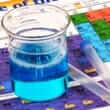Background
- Bismuth (Bi) is a chemical element whose atomic number is 83. Bismuth-containing compounds include cosmetics (bismuth oxychloride) and certain drugs. Bismuth is also used in some medical procedures. Bismuth has been used for approximately a hundred years for stomach and intestinal conditions and was the first drug shown to affect the progression of peptic ulcer disease. The historical use of bismuth has been discussed in various reviews.
- Although the element bismuth has been used since at least the 18th Century, most bismuth-containing products available on the market now are multi-ingredient products or are used in combination with other drugs. These multi-ingredient products will be only briefly discussed in this monograph.
- Examples of bismuth products used in medicine include bismuth subnitrate, bismuth subcarbonate, bismuth subsalicylate (e.g., Pepto-Bismol®, Kaopectate®), bismuth subgallate (e.g., Devrom®), colloidal bismuth subcitrate (e.g., De-Nol®), and ranitidine bismuth subcitrate.
- Some preliminary evidence suggests that bismuth carbomer enemas may reduce pouchitis (inflammation in the pouch) that may occur after colon removal. Bismuth subnitrate has been used for treatment of Helicobacter pylori infection, typically in combination with antibiotics, with limited evidence of benefit. Bismuth subgallate has been studied for controlling odor after an ileostomy (a hole surgically constructed in the abdomen to eliminate waste).
References
- Cengiz N, Uslu Y, Gok F, Anarat A. Acute renal failure after overdose of colloidal bismuth subcitrate. Pediatr Nephrol 2005;20(9):1355-1358. View Abstract
- DuPont HL, Ericsson CD, Johnson PC, Bitsura JA, DuPont, MW, de la Cabada FJ. Prevention of travelers' diarrhea by the tablet formulation of bismuth subsalicylate. JAMA 3-13-1987;257(10):1347-1350. View Abstract
- Gionchetti P, Rizzello F, Venturi A, et al. Long-term efficacy of bismuth carbomer enemas in patients with treatment-resistant chronic pouchitis. Aliment.Pharmacol Ther 1997;11(4):673-678. View Abstract
- Holmberg G. Diagnostic aspects, functional significance and therapy of simple renal cysts: a clinical, radiologic and experimental study. Scand J Urol.Nephrol.Suppl 1992;145:1-48. View Abstract
- Mishkin S. Intriguing gastrointestinal properties of bismuth: a folk remedy brought into the realm of clinical and investigative medicine. Can J Gastroenterol. 1998;12(8):569-570. View Abstract
- Noach LA, Eekhof JL, Bour LJ, Posthumus Meyjes FE, Tytgat GN, and Ongerboer de Visser BW. Bismuth salts and neurotoxicity. A randomised, single-blind and controlled study. Hum.Exp Toxicol 1995;14(4):349-355. View Abstract
- Pugh S, Lewin MR. Mechanism of action of Roter (bismuth subnitrate) in patients with duodenal ulcer disease and healthy volunteers. J Gastroenterol Hepatol 1990;5(4):382-386. View Abstract
- Slikkerveer, A. and de Wolff, F. A. Bismuth poisoning and chelation. J Toxicol.Clin Toxicol. 1993;31(2):365-366. View Abstract
- Sorensen WT, Henrichsen J, Bonding P. Does bismuth subgallate have haemostatic effects in tonsillectomy? Clin Otolaryngol.Allied Sci 1999;24(1):72-74. View Abstract
- Sparberg M. Correspondence: Bismuth subgallate as an effective means for the control of ileostomy odor: a double blind study. Gastroenterology 1974;66(3):476. View Abstract
- Topfmeier P, Eberhardt R, Mateblowski M, Kuhn D. Ulcer relapse rates following initial treatment with bismuth subnitrate as compared with cimetidine respectively. Int J Clin Pharmacol Ther Toxicol 1991;29(11):437-440. View Abstract
- Tremaine WJ, Sandborn WJ, Wolff BG, Carpenter HA, Zinsmeister AR, Metzger PP. Bismuth carbomer foam enemas for active chronic pouchitis: a randomized, double-blind, placebo-controlled trial. Aliment.Pharmacol Ther 1997;11(6):1041-1046. View Abstract
- Wagstaff AJ, Benfield P, Monk JP. Colloidal bismuth subcitrate. A review of its pharmacodynamic and pharmacokinetic properties, and its therapeutic use in peptic ulcer disease. Drugs 1988;36(2):132-157. View Abstract
- Whitehead MW, Phillips RH, Sieniawska CE, et al. Double-blind comparison of absorbable colloidal bismuth subcitrate and nonabsorbable bismuth subnitrate in the eradication of Helicobacter pylori and the relief of nonulcer dyspepsia. Helicobacter. 2000;5(3):169-175. View Abstract
- Xia HH, Yu Wong BC, Talley NJ, Lam SK. Alternative and rescue treatment regimens for Helicobacter pylori eradication. Expert.Opin.Pharmacother. 2002;3(9):1301-1311. View Abstract







